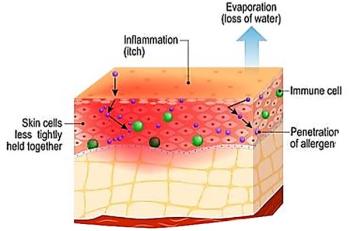
New Ways to Quell Mild Persistent Asthma
WINSTON-SALEM, N.C. -- For patients with mild persistent asthma, treatment options appear to have widened, according to two randomized trials.
WINSTON-SALEM, N.C., May 16 -- For patients with mild persistent asthma, treatment options appear to have widened, according to two randomized trials reported today.
An evaluation of "stepping down" therapy to the minimum needed to control symptoms showed the procedure is safe and effective, found Stephen Peters, M.D., Ph.D., of Wake Forest University Baptist Medical Center and colleagues at 20 other centers.
And an Italian trial of as-needed rescue medication showed that use of salbutamol driven by symptoms is as effective as regular use of beclomethasone (QVAR) and better than as-needed use of albuterol (Ventolin), found Alberto Papi, M.D., of the University of Ferrara.
The results of both studies were reported in the May 17 issue of the New England Journal of Medicine.
The step-down study "is good news for patients with mild, persistent asthma because it gives them more choices about how to manage their disease," Dr. Peters said.
He and colleagues in the American Lung Association Asthma Clinical Research Centers hypothesized that patients whose asthma was well-controlled by fluticasone (Flovent) twice a day would do as well with either:
- Five or 10 mg of montelukast (Singulair) each night, or
- 100 mcg of fluticasone plus 50 mch of salmeterol (Advair) each night.
The primary outcome was time to treatment failure.
The researchers randomized 500 patients to continued treatment with fluticasone, to nightly montelukast, or to nightly fluticasone/salmeterol for a 16 weeks
The researchers found that 20.2% of those continuing treatment and 20.4% of those switched to fluticasone/salmeterol had treatment failure, compared with 30.3% of volunteers switched to montelukast.
The failure rate for montelukast was about 60% higher than either of the other treatments (the hazard ratio for both comparisons was 1.6 with a 95% confidence interval from 1.1 to 2.6), which was significant at P=0.03.
On the other hand, the proportion of days on which patients were free of asthma symptoms - ranging from 78.7% to 85.8% -- was similar across the three groups.
The results of the study show that the combination works as well as the standard treatment, Dr. Peters said, but doesn't rule out the use of montelukast.
"While the group on the combination inhaler therapy clearly did better than those on the oral montelukast therapy, it is important to note that 70% of patients on this oral therapy did well according to the treatment failure criteria, and were symptom-free on 79% of days," he said.
In Italy, Dr. Papi and colleagues conducted a six-month, double-blind study, in 455 patients, of four inhaled treatments:
- Regular beclomethasone therapy -- 250 mcg of beclomethasone twice daily and 100 mcg of albuterol as needed.
- Regular combination therapy -- 250 mcg of beclomethasone and 100 mcg of albuterol in a single inhaler (also known as salbutamol) twice daily plus 100 mcg of albuterol as needed.
- An as-needed combination therapy -- placebo twice daily plus 250 mcg of beclomethasone and 100 mcg of albuterol in a single inhaler, used when symptoms required.
- An as-needed albuterol therapy -- placebo twice daily plus 100 mcg of albuterol when symptoms required.
The primary outcome was the morning peak expiratory flow rate.
The study found that during the last two weeks of the six-month treatment period, morning peak expiratory flow rate:
- Was significantly higher (P=0.04) in the as-needed combination therapy group than in the as-needed albuterol group.
- But the rate in the as-needed combination therapy group was not significantly different from that seen in the remaining two groups.
- At the same time, the number of exacerbations was significantly lower (P=0.002) in the as-needed combination therapy group compared to the as-needed albuterol group.
- Again, the values in the as-needed combination therapy group were not significantly different from those in the remaining two groups.
- The cumulative dose of inhaled beclomethasone was significantly lower in the as-needed combination therapy group than in the other groups receiving beclomethasone (at P<0.001 for each comparison).
This results suggest that "mild persistent asthma may not require regular treatment with inhaled corticosteroids, but rather only as-needed use of an inhaled corticosteroid and an inhaled bronchodilator," Dr. Papi and colleagues concluded.
They noted that the beclomethasone dose in the study was "relatively high."
The study also "confirms and extends" an earlier result that showed as-needed therapy was as effective as routine use of steroids, the researchers said. (
The as-needed study was supported by Chiesi Farmaceutici. Dr. Papi reports financial links to Chiesi Farmaceutici, GlaxoSmithKline, AstraZeneca, Boehringer Ingelheim, and Merck Sharp & Dohme. Other authors report financial links to some or all of the following: Schering-Plough, Uriach, Almirall, Alk-Abello, GlaxoSmithKline, Novartis, Menarini, UCB, Boehringer Ingelheim, Merck Sharp & Dohme, Domp, AstraZeneca, Altana, Gentili, Gaalem, Chiesi Farmaceutici, Stallergenes, Roche, Pfizer, Menarini, Miat, and Zambon. Co-author Paolo Morelli, Ph.D., is the director of Contract Research Organization Statistics and Data Management, the contract research organization hired by Chiesi Farmaceutici for the statistical analysis. Gabriele Nicolini, Pharm.D., is an employee of Chiesi Farmaceutici.
Newsletter
Enhance your clinical practice with the Patient Care newsletter, offering the latest evidence-based guidelines, diagnostic insights, and treatment strategies for primary care physicians.































































































































































































































































































































